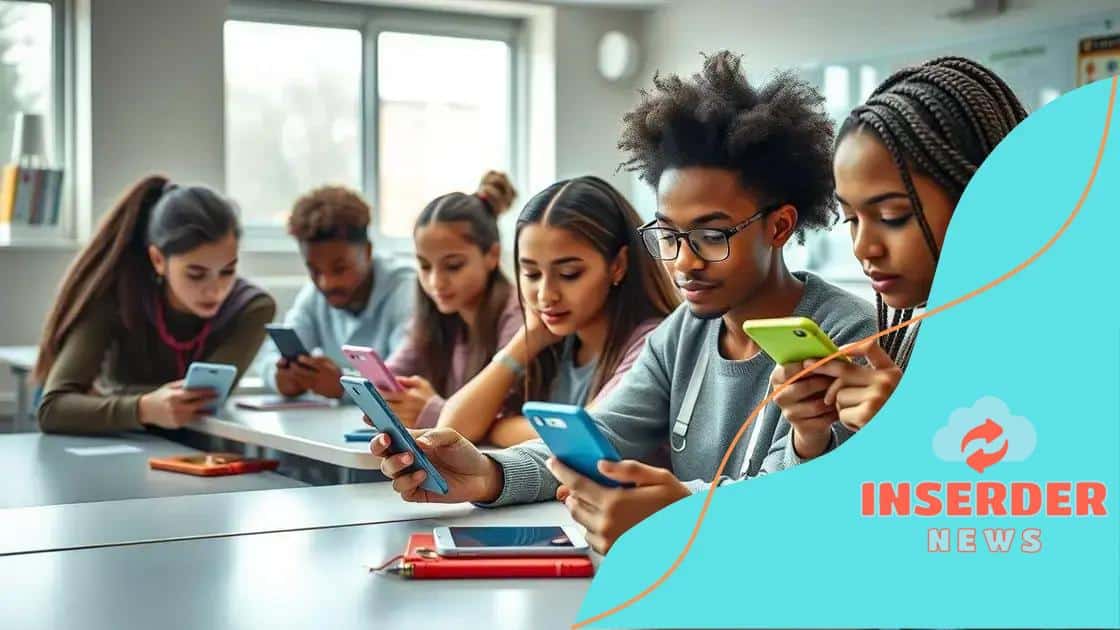The impact of mobile learning apps on education

The impact of mobile learning apps on education includes enhanced accessibility, personalized experiences, and increased engagement through interactive features, shaping the future of learning with advanced technologies like AI and AR/VR.
The impact of mobile learning apps on education is more significant than ever. Have you noticed how these tools enhance learning experiences? Let’s dive deeper into these exciting changes.
Understanding mobile learning apps
Understanding mobile learning apps is essential in today’s digital age. These applications play a crucial role in reshaping education, allowing students to learn anywhere and anytime. As education evolves, the use of technology becomes more integrated, making it possible for learners to access resources at their fingertips.
What Are Mobile Learning Apps?
Mobile learning apps, or m-learning apps, are software applications designed to facilitate learning through portable devices like smartphones and tablets. They offer a variety of features that enhance the learning experience. Some key aspects include:
- Access to a wide range of educational materials.
- Interactive and engaging content.
- Flexibility in learning schedules.
- Opportunities for collaborative learning.
These apps provide an engaging way for learners to interact with educational content. For example, through gamification and multimedia resources, students can enjoy a more immersive learning experience. Moreover, they often include progress tracking, which helps learners monitor their development.
Benefits of Mobile Learning Apps
There are several benefits associated with using mobile learning apps. Increased accessibility is a primary advantage, allowing users to learn from various locations. Additionally, these apps promote personalized learning experiences. Here are some notable benefits:
- Enhanced engagement through interactive features.
- Immediate feedback that fosters improvement.
- Increased retention of information.
By offering diverse learning methods, mobile learning apps address different learning styles, making education more inclusive. Incorporating these apps into educational strategies helps cater to various student needs and preferences, ultimately enhancing comprehension and retention.
Learning on the go is becoming the norm, with students utilizing mobile learning apps during commutes, breaks, or at home. This flexibility enables learners to make the most of their time while optimizing their educational journey.
Benefits of mobile learning in education
The benefits of mobile learning in education are significant and transformative. By integrating mobile technology into learning processes, students can experience education in a more engaging and effective way. This approach allows for a personalized learning journey that suits individual needs.
Enhanced Accessibility
One of the primary advantages of mobile learning is enhanced accessibility. Learners can access educational materials from anywhere, whether they are at home, school, or on the go. This flexibility means that they can study whenever it fits their schedule, making learning more convenient and effective.
- Students can learn in various environments.
- Materials are often available in a single app.
- Access to global resources is easily achieved.
Additionally, mobile learning encourages independent study. Students who may feel uncomfortable in traditional classroom settings can engage with content at their own pace, helping to build confidence and autonomy. They can revisit complex topics and reinforce their understanding without pressure.
Interactivity and Engagement
Mobile learning apps often incorporate interactive elements that capture students’ attention. Features such as quizzes, videos, and gamification elements make learning more exciting and enjoyable. By engaging with content through multimedia, students are more likely to retain information. Here are key interactive features:
- Gamified learning experiences motivate students.
- Instant feedback helps learners improve.
- Social features facilitate collaboration.
Moreover, the use of mobile devices allows for real-time collaboration among peers. Students can share ideas, discuss topics, and work on projects together regardless of their physical location. This collaborative aspect enhances their learning experience and fosters teamwork skills.
Overall, the benefits of mobile learning in education are vast. By embracing this innovative approach, educators can provide more engaging, flexible, and personalized learning experiences that cater to the diverse needs of today’s learners.
Challenges faced by mobile learning apps

Challenges faced by mobile learning apps can significantly impact their effectiveness. While these tools offer many benefits, some obstacles can hinder their success. Understanding these challenges is essential for both developers and educators to create better learning experiences.
Technical Issues
One major challenge is the technical issues that can arise. Poor connectivity or outdated devices can limit access to materials. Students may become frustrated when apps do not load or function as expected. Additionally, not all apps are compatible with every device, which can create barriers for users.
- Slow internet connections can disrupt learning.
- Incompatibility with older devices limits accessibility.
- Technical glitches can discourage student engagement.
Moreover, frequent updates or maintenance can lead to downtime, making resources temporarily unavailable. Developers must prioritize compatibility and performance to overcome these technical challenges.
User Experience Design
Poor user experience is another critical challenge. If an app is not intuitive or user-friendly, students may struggle to navigate it. A complicated interface can lead to confusion and disengagement. Features should promote ease of use, allowing students to focus on learning rather than troubleshooting.
- Complex navigation can frustrate users.
- Overly cluttered designs can distract from content.
- Accessibility options must meet diverse needs.
Additionally, not incorporating feedback from users can result in missing essential features or improvements. It is vital for developers to listen to students’ and educators’ needs to create a more satisfying learning experience.
Another significant hurdle is the lack of motivation for self-directed learning. Mobile learning apps often require students to take charge of their education. However, some learners may struggle with motivation, leading to a lack of engagement. Creating engaging content and incorporating rewards can help mitigate this challenge.
Addressing these challenges is crucial for maximizing the potential of mobile learning apps. Innovations in technology, focused user design, and ongoing learner engagement strategies are essential steps to improving educational outcomes in this space.
Key features of effective mobile learning applications
Key features of effective mobile learning applications play a vital role in enhancing the educational experience. To engage students and promote effective learning, apps should include several essential elements that meet the needs of diverse learners.
User-Friendly Interface
First and foremost, a user-friendly interface is crucial. When students can easily navigate through the app, they are more likely to engage with the content. An intuitive layout reduces frustration and allows learners to focus on studying rather than figuring out how to use the app.
- Clear menus and navigation paths.
- Simple, uncluttered design.
- Consistent layout throughout the app.
In addition to a user-friendly interface, the use of engaging content is another key feature. Effective apps utilize various media types, such as videos, animations, and quizzes, to keep students interested. Incorporating interactive elements helps to reinforce learning and allows students to apply what they have learned.
Personalized Learning Experience
Another essential feature is the ability to provide a personalized learning experience. This can be achieved through adaptive learning technologies that tailor content to individual student needs. By assessing each learner’s progress and adjusting the material accordingly, mobile learning apps can help students master subjects at their own pace.
- Customized learning paths based on performance.
- Recommendations for additional resources.
- Progress tracking to encourage goal setting.
Moreover, effective mobile learning applications should include offline access. This feature ensures that students can learn without needing a constant internet connection. Allowing users to download content for offline study lets them learn during commutes or in places where connectivity may be limited.
Additionally, incorporating social learning features can enhance collaboration among students. By enabling peer interaction, discussions, and sharing of resources, mobile applications can create a supportive environment that fosters teamwork and communication skills.
Overall, understanding the key features of effective mobile learning applications is essential to creating a successful educational tool. By focusing on user experience, personalized learning, and interactive content, developers can ensure that these applications effectively support learners in their educational journeys.
Future trends in mobile learning
Future trends in mobile learning are shaping the way education is delivered. As technology evolves, new methodologies are emerging to enhance student learning experiences. Understanding these trends is essential for educators and developers aiming to maximize the potential of mobile learning applications.
Increased Use of Artificial Intelligence
One major trend is the integration of artificial intelligence (AI) into mobile learning apps. AI can provide personalized learning experiences by adapting content to fit individual student needs. For example, smart algorithms analyze a learner’s progress and recommend tailored resources to help them succeed.
- Adaptive learning paths customize educational journeys.
- AI-driven chatbots provide instant support and feedback.
- Intelligent assessments track and analyze learner outcomes.
This use of AI enhances engagement and helps students tackle subjects at their own pace, making learning more effective.
Augmented and Virtual Reality
Another exciting trend is the use of augmented (AR) and virtual reality (VR) in education. These technologies allow students to immerse themselves in interactive environments that enhance their understanding of complex topics. For instance, learners can explore historical sites or conduct virtual science experiments right from their devices.
- AR provides interactive overlays that enrich learning contexts.
- VR creates immersive, simulated environments for hands-on experiences.
- Both technologies promote collaboration and creativity among students.
The incorporation of AR and VR can significantly increase student motivation and retention by making learning more engaging and memorable.
Additionally, the rise of mobile micro-learning is another trend to watch. Short, focused learning modules are becoming popular as they allow students to fit learning into their busy schedules. These bite-sized lessons can be easily consumed, promoting continuous learning and retention of information.
Furthermore, social learning will continue to expand, with mobile platforms incorporating more collaborative tools. Students will have opportunities to connect, share, and learn from one another, enhancing their educational experiences through peer interaction and feedback.
Ultimately, as technology continues to advance, the future of mobile learning will likely see even more innovative solutions. By staying informed about these trends, educators and developers can ensure they are providing the best learning experiences for students.
FAQ – Frequently Asked Questions about Mobile Learning Apps
What are mobile learning apps?
Mobile learning apps are software applications designed to facilitate education through mobile devices like smartphones and tablets. They allow learning anytime, anywhere.
How can mobile learning apps enhance student engagement?
They incorporate interactive elements like quizzes, videos, and gamification, making learning more enjoyable and helping students retain information better.
What role does AI play in mobile learning?
AI can personalize learning experiences by adapting content to individual student needs, providing tailored recommendations, and analyzing learning progress.
What are some future trends in mobile learning?
Future trends include increased use of artificial intelligence, augmented and virtual reality, and a move toward mobile micro-learning for quick, focused study sessions.






